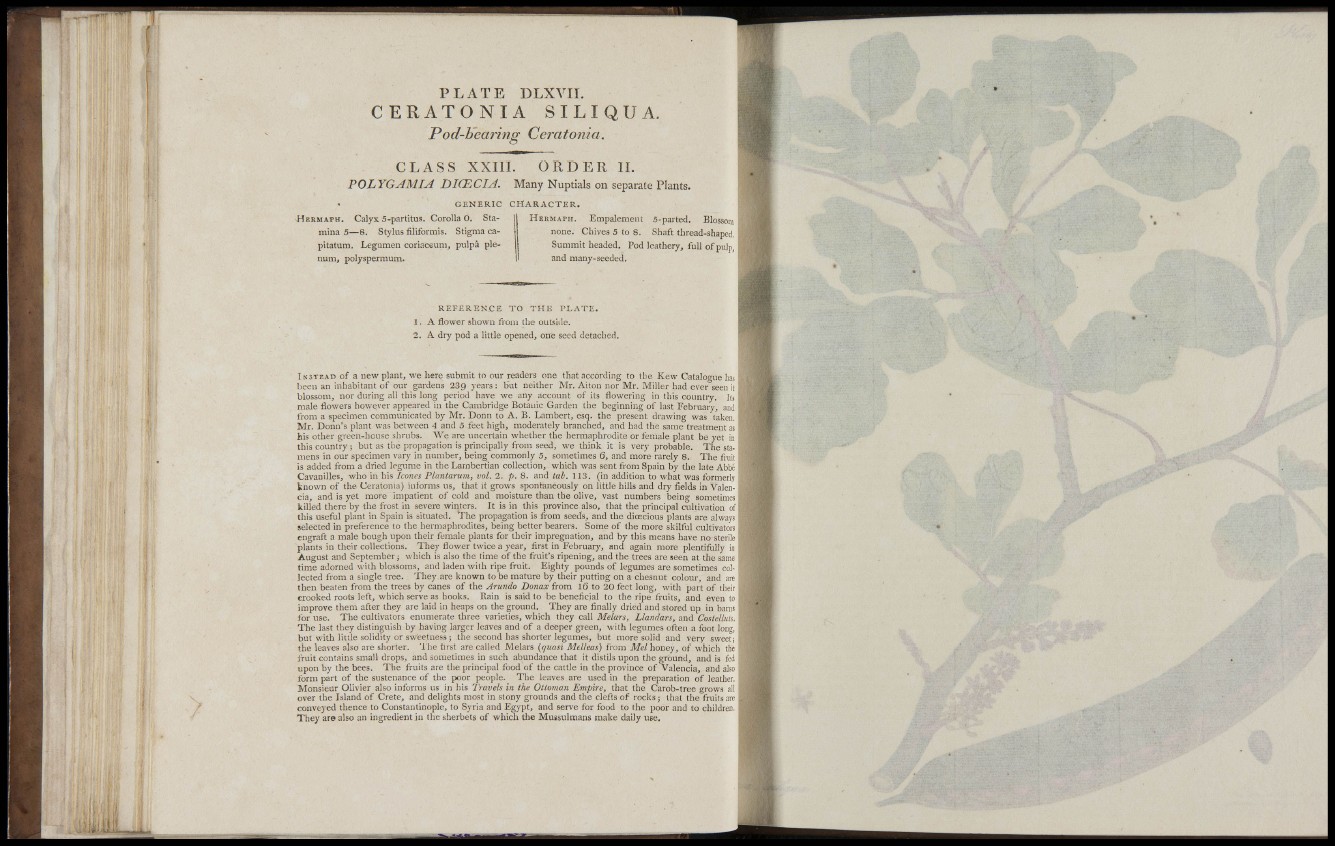
P L A T E DLXVII.
C E R A T O N I A SILIQUA.
Pod-bearinQ' Ceratonia. o
C L A S S XXIIL ORDER IL
POLYGAMIA DICECIA. Many Nuptials on separate Plants.
GENERIC CHARACTER.
HERMAPH. Calyx 5-partitus. Corolla 0. Stamina
5—8. Stylus filiformis. Stigma capitatum.
Legumen coriaceum^ pulpà plenum,
polyspermum.
HERMAPH. Empalement s-parted. Blossom
none. Chives 5 to 8. Shaft thread-shaped,
Summit headed. Pod leathery, full of pulp,
and many-seeded.
REFERENCE TO THE PLATE.
1. A flower shown from the outside.
2. A. dry pod a little opened, one seed detached.
INSTEAD of a new plant, we here submit to our readers one that according to the Kew Cataloo-ue lias
been an inhabitant of our gardens 239 years : but neither Mr. Aiton nor Mr. Miller had ever seen it
blossom, nor during all this long period have we any account of its flowering in this country. Itj
male flowers hoN^'ever appeared in the Cambridge Botanic Garden the beginning of last February, and
from a specimen communicated by Mr. Donn to A. B. Lambert, esq. the present drawing was taken,
Mr. Donn's plant was between 4 and 5 feet high, moderately branched, and had the same treatment as
his other green-hcuse shrubs. We are uncertain whether the hermaphrodite or female plant be yet in
this country; but as the propagation is principally from seed, we think it is very probable. The stamens
in our specimen vary in number, being commonly 5, sometimes 6, and more rarely 8. The fruit
is added from a dried legimre in the Lambertian collection, which was sent from Spain by the late Abbé
Cavanilles, who in his /co72es PLantarum, vol. 2. p. 8. and tal. 113. (in addition to what was formerlj
known of the Ceratonia) informs us, that it grows spontaneously on little hills and dry fields in Valencia,
and is yet more impatient of cold and moisture than the olive, vast numbers being sometimes
killed there by the frost in severe winters. It is in this province also, that the principal cultivation of
this useful plant in Spain is situated. The propagation is from seeds, and the dioecious plants are always
selected in preference to the hermaphrodites, being better bearers. Some of the more skilful cultivators
engraft a male bough upon their female plants for their Impregnation, and by this means have no sterile
plants in their collections. They flower twice a year, first in February, and again more plentifully in
August and September; which is also the time of the fruit's ripening, and the trees are seen at the same
time adorned with blossoms, and laden with ripe fruit. Eighty pounds of legumes are sometimes collected
from a single tree. They are known to be mature by their putting on a chesnut colour, and are
then beaten from the trees by canes of the Arundo Bonax from 16 to 20 feet long, with part of their
crooked roots left, which serve as hooks. Rain is said to be beneficial to the ripe fruits, and even to
improve them after they are laid in heaps on the ground. They are finally dried and stored up in barns
for use. The cultivators enumerate three varieties, which tliey call Melars, Llandars, and CostelliUs.
The last they distinguish by having larger leaves and of a deeper green, with legumes often a foot long,
but with little solidity or sweetness ; the second has shorter legumes, but more solid and very sweefj
the leaves also are shorter. The first are called Melars {quasi MtUeas) from Mel honey, of which the
fruit contains small drops, and sometimes in such abundance that it distils upon the ground, and is fed
upon by the bees. The fruits are the principal food of the cattle in the province of Valencia, and also
form part of the sustenance of the poor people. The leaves are used in the preparation of leather.
Monsieur Olivier also informs us in his Travels in the Ottoman Empire, that the Carob-tree grows all
over the Island of Crete, and delights most in stony grounds and the clefts of rocks ; that the fruits are
conveyed thence to Constantinople, to Syria and Egypt, and serve for food to the poor and to children.
They are also an ingredient in the sherbets of which the Mussulmans make daily use.
•JFT